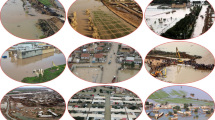Abstract
Water is one of the most common and important objects on the earth, and its extraction is of great significance to many related researches in remote sensing domain. However, water always appears diversely, which makes its extraction not so simple. Many former methods are developed to extract water, which mainly based on a single model and only use spectral information, but the results are not so satisfying. An adaptive extraction method based on normalized difference water index (NDWI) is proposed here to extract water completely and accurately from remote sensing image. This study first compute NDWI to enhance water’s spectral information, and then it is redefined so as to use the modified histogram auto-segmentation method to initially separate water from background; next, after segmentation, water pixels can be searched out and are taken as seed points to proceed region growing to get the local area of water; last, the edge of the local area is searched by a window template, and iterative classification within it is employed to precisely extract water’s precise partition. Experiments are carried out here on an ETM+ image of a paralic area to extract water. Through comparison with other commonly used methods, it shows that the performance of the proposed method is superior to the others.









Similar content being viewed by others
References
Bazi, Y., & Melgani, F. (2006). Toward an optimal SVM classification system for hyperspectral remote sensing images. IEEE Transactions on Geoscience and Remote Sensing, 44, 3374–3385.
Chandranath, C., Rakesh, K., & Pankaj, M. (2003). Delineation of surface waterlogged areas in parts of bihar using IRS-1C LISS-III data. Journal of the Indian Society of Remote Sensing, 31(1), 57–65.
Delon, J., Desolneux, A., Lietrosani, J. L., & Petro, A. B. (2007). A nonparametric approach for histogram segmentation. IEEE Transactions on Image Processing, 16, 253–261.
Gao, B. C. (1996). NDWI—a normalized difference water index for remote sensing of vegetation liquid water from space. Remote Sensing of Environment, 58, 257–266.
Giada, S., De, G. T., Ehrlich, D., & Soille, P. (2010). Information extraction from very high resolution satellite imagery over Lukole refugee camp, Tanzania. International Journal of Remote Sensing, 24, 4251–4266.
Gonzalez, R. C., & Woods, R. E. (2002). Digital image processing (2nd ed.). Upper Saddle River: Prentice Hall.
Hagner, O., & Reese, H. (2007). A method for calibrated maximum likelihood classification of forest types. Remote Sensing of Environment, 110, 438–444.
Hu, D. Y., Zhao, W. L., Gong, H. L., Li, X J., & Li, J. C. (2008). Thematic information extraction from IKONOS imagery based on object and various features. In IGARSS2008 (pp. IV-814–IV-817). Boston, MA.
Jimenez, L. O., Rivera-Medina, J. L., Rodriguez-Diaz, E., Arzuaga-Cruz, E., & Ramirez-Velez, M. (2005). Integration of spatial and spectral information by means of unsupervised extraction and classification for homogenous objects applied to multispectral and hyperspectral data. IEEE Transactions on Geoscience and Remote Sensing, 43, 844–851.
Lasaponara, R., & Masini, N. (2006). Identification of archaeological buried remains based on the normalized difference vegetation index (NDVI) from Quickbird satellite data. IEEE Geoscience and Remote Sensing Letters, 3, 325–328.
Li, J., & Narayanan, R. M. (2004). Integrated spectral and spatial information mining in remote sensing imagery. IEEE Transactions on Geoscience and Remote Sensing, 42, 673–685.
Luo, J. C., Sheng, Y. W., Shen, Z. F., Li, J. L., & Gao, L. J. (2009). Automatic and high-precise extraction for water information from multispectral images with the step-by-step iterative transformation mechanism. Journal of Remote Sensing, 13, 610–622 [in Chinese].
McFeeters, S. K. (1996). The use of normalized difference water index (NDWI) in the delineation of open water features. International Journal of Remote Sensing, 17, 1425–1432.
Miguel-Ayanz, J. S., & Biging, G. S. (1996). An iterative classification approach for mapping natural resources from satellite imagery. International Journal of Remote Sensing, 17, 957–981.
Miller, H. J. (2004). Tobler’s first law and spatial analysis. Annals of the Association of American Geographers, 94, 269–277.
Myint, S. W. (2008). An exploration of spatial dispersion, pattern, and association of socio-economic functional units in an urban system. Applied Geography, 28, 168–188.
Nath, S. K., & Dubois, E. (2006). An improved, wavelet-based, stereoscopic image sequence codec with SNR and spatial scalability. Signal Processing: Image Communication, 21(3), 181–199.
Ouma, Y. O., & Tateishi, R. (2006). A water index for rapid mapping of shoreline changes of five East African Rift Valley lakes: an empirical analysis using Landsat TM and ETM+ data. International Journal of Remote Sensing, 27, 3153–3181.
Qin, A. K., & Clausi, D. A. (2010). Multivariate image segmentation using semantic region growing with adaptive edge penalty. IEEE Transactions on Image Processing, 19, 2157–2170.
Ren, K., Sun, H., Jia, Q., & Shi, J. (2009). Building recognition from aerial images combining segmentation and shadow. In Conf. ICIS 2009 IEEE Int. Conf., Shanghai (pp. 578–582).
Robert, A. S. (2007). Remote sensing: Models and methods for image processing (3rd ed.). Burlington: Elsevier.
Rundquist, D., Lawson, M., Queen, L., & Cerveny, R. (1987). The relationship between the timing of summer-season rainfall events and lake-surface area. Water Resources Bulletin, 23, 493–508.
Xu, H. Q. (2006). Modification of normalised difference water index (NDWI) to enhance open water features in remotely sensed imagery. International Journal of Remote Sensing, 27, 3025–3033.
Yu, Q. Y., & Clausi, D. A. (2008). IRGS: image segmentation using edge penalties and region growing. IEEE Transactions on Pattern Analysis and Machine Intelligence, 30, 2126–2139.
Acknowledgements
This study was supported by National Natural Science Foundation of China under Grants 40971228 and 40871203, and Major Projects on Control and Rectification of Water Body Pollution of China under Grant 2009ZX07318-001.
Author information
Authors and Affiliations
Corresponding author
About this article
Cite this article
Qiao, C., Luo, J., Sheng, Y. et al. An Adaptive Water Extraction Method from Remote Sensing Image Based on NDWI. J Indian Soc Remote Sens 40, 421–433 (2012). https://doi.org/10.1007/s12524-011-0162-7
Received:
Accepted:
Published:
Issue Date:
DOI: https://doi.org/10.1007/s12524-011-0162-7




